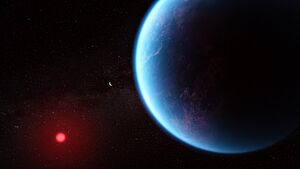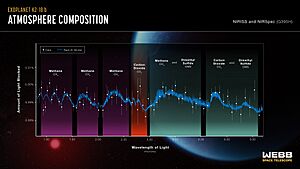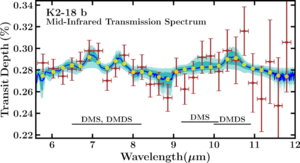K2-18b facts for kids

|
|
| Discovery | |
|---|---|
| Discovery site | Kepler space telescope |
| Discovery date | 2015 |
|
Detection method
|
Transit |
| Orbital characteristics | |
| 0.15910+0.00046 −0.00047 au 21,380,000 km |
|
| Eccentricity | 0.09+0.12 −0.09 |
| 32.940045±0.000100 d | |
| 354.3+46.4 −33.8° |
|
| Star | K2-18 |
| Physical characteristics | |
|
Mean radius
|
2.610±0.087 R⊕ |
| Mass | 8.63±1.35 M⊕ |
|
Mean density
|
2.67+0.52 −0.47 g/cm3 |
| 12.43+2.17 −2.07 m/s2 |
|
| Temperature | 265 ± 5 K (−8 ± 5 °C) |
K2-18b is an exoplanet that orbits a star called K2-18. This star is a red dwarf, which is smaller and cooler than our Sun. K2-18b is about 124 light-years away from Earth.
This planet is a type of planet called a sub-Neptune. It is about 2.6 times bigger than Earth. K2-18b orbits its star in about 33 days. It is located in the star's habitable zone. This means it gets a similar amount of light from its star as Earth gets from the Sun.
Scientists first found K2-18b in 2015 using the Kepler space telescope. Later, the James Webb Space Telescope (JWST) studied its atmosphere. In 2019, scientists found water vapour in its atmosphere. This made K2-18b very interesting to study. In 2023, the JWST also found carbon dioxide and methane there.
Some scientists think K2-18b might be a water world with a thick, hydrogen-rich atmosphere. Others think it's more like a mini-Neptune, a gas-rich planet. K2-18b is often compared to ice giant planets like Uranus or Neptune, not Earth.
In 2025, there were reports that K2-18b's atmosphere might have dimethyl sulfide (DMS). On Earth, DMS is mostly made by living things, like tiny ocean plants. So, finding it on another planet could be a sign of life. However, some scientists have questioned these claims. They point out that DMS can also be made without life in lab experiments.
Contents
The Star K2-18
K2-18 is a small, cool star. It is much colder and smaller than our Sun. Its temperature is about 3,184 degrees Celsius. Its size is about 45% of the Sun's size. You cannot see K2-18 from Earth without a telescope.
The star is about 2.4 billion years old. It has some stellar activity, like flares. It is not clear if it has star spots. These spots can make it harder to study planets that pass in front of the star. K2-18 also has another planet, K2-18c, which orbits closer to the star than K2-18b.
Scientists believe that many M dwarf stars, like K2-18, have planets in their habitable zones. This includes stars like LHS 1140, Proxima Centauri, and TRAPPIST-1. It is easier to study planets around these small stars. However, their low brightness can make it hard to analyze the planets' atmospheres. Also, these stars can be very active, which can create confusing signals.
What K2-18b is Like
K2-18b is about 2.6 times the radius of Earth. It has a mass about 8.6 times the mass of Earth. It takes 33 days to orbit its star. From Earth, we can see it pass in front of its star. This is how scientists study its atmosphere.
The planet is likely tidally locked to its star. This means one side always faces the star, like our Moon always shows the same side to Earth. However, it might also have a special spin-orbit pattern, like Mercury.
K2-18b's density is between that of Earth and Neptune. This suggests it has a thick layer of hydrogen gas. The planet could be a rocky world with a very thick atmosphere. Or, it could be more like Neptune, made mostly of gases and ice. A planet made purely of water with a thin atmosphere is less likely.
Planets that are about 1.5 to 2 times the size of Earth are rare. This is called the radius valley. It means planets of this size often lose their atmospheres. But K2-18b is larger than this "valley," so it can hold onto its atmosphere.
Scientists think K2-18b might have formed in a few million years. It's unlikely to have much internal heating from tides. If it has an ocean, it might be under a layer of high-pressure ice. This could make the planet's climate unstable.
Could K2-18b Have an Ocean?
It's hard to tell if K2-18b has a liquid ocean. When liquids get very hot and pressurized, they can become a supercritical fluid. This means there's no clear difference between the liquid and gas.
Early observations from the James Webb Space Telescope suggested a liquid ocean might exist. This is because certain gases, like hydrocarbons and ammonia, would dissolve into an ocean if it were there. If these gases are missing from the atmosphere, it could mean an ocean is present. However, later studies suggest other possibilities, like a magma ocean. Some models even suggest that a liquid water ocean would need life to produce enough methane. So, whether a liquid ocean exists is still a big question.
K2-18b's Atmosphere and Weather
The Hubble Space Telescope found that K2-18b's atmosphere is mostly hydrogen. The James Webb Space Telescope found small amounts of water vapour, less than 0.1%. This might be because the JWST sees a dry upper atmosphere.
The JWST also found that methane and carbon dioxide each make up about 1% of the atmosphere. The atmosphere of K2-18b is probably similar to that of Uranus and Neptune. It makes up at most 6.2% of the planet's total mass.
There isn't much sign of hazes in the atmosphere. There is some conflicting evidence for water clouds. If clouds exist, they are likely made of ice, but liquid water clouds are also possible. Other chemicals like ammonium chloride could also form clouds. Most computer models suggest that the upper atmosphere has a temperature inversion, meaning it gets warmer higher up.
How the Atmosphere Changes
High-energy radiation from the star, like UV light and X-rays, heats the upper atmosphere. This radiation can break down water molecules, creating hydrogen. This hydrogen can then escape from the planet.
K2-18b gets much more of this high-energy radiation than Earth does from the Sun. However, the atmosphere is escaping very slowly. It's not fast enough to remove the planet's atmosphere during its lifetime. Scientists have seen possible signs of this escaping hydrogen when the planet passes in front of its star. More observations are needed to confirm this.
Different Ideas About the Atmosphere
Studying atmospheres on distant planets is very hard. Some findings can be debated. For example, some scientists thought the water vapor signal might be from the star itself, not the planet. Others suggested that methane might be a much larger part of the atmosphere, and that the water signal was actually due to methane. These are all ideas that scientists are still exploring.
Climate Models
Scientists use computer models to guess what K2-18b's climate might be like. These models help them understand how the atmosphere moves and what temperatures are like.
- One model from 2021 suggested that if K2-18b is tidally locked, it would have weak temperature changes across the planet. Air would rise on the day side and sink on the night side. Clouds would form mostly where the star's light hits directly and at the edges of day and night. If it rained, the rain would evaporate before reaching the surface.
- Another study in 2022 looked at different rotation speeds. It found that there wouldn't be a big temperature difference between the poles and the equator, except for very fast rotations.
- A 2021 study on the planet's chemistry predicted that certain chemicals like carbon oxides and cyanide could be found in the middle atmosphere. It also suggested a sulfur haze layer could form, making it harder to study the atmosphere.
- In 2024, models suggested a strong wind system in the atmosphere. They also reported a possible detection of dimethyl sulfide (DMS). For DMS to be detectable, its production would need to be 20 times higher than on Earth.
Can K2-18b Support Life?
K2-18b receives a similar amount of energy from its star as Earth gets from the Sun. It is located within or very close to its star's habitable zone. This is the region where temperatures might allow liquid water to exist on a planet's surface.
The planet's temperature without a greenhouse effect would be around -23 to 27 degrees Celsius. Whether it can actually support life depends on its atmosphere and clouds. The deeper parts of its atmosphere might be too hot. But the layers with water might have the right temperatures and pressures for life to develop.
Scientists know that tiny living things from Earth can survive in hydrogen-rich atmospheres. This means hydrogen itself isn't a problem for life. However, the usual signs of life (called biosignatures) that we look for might not work the same way in a hydrogen atmosphere. So, scientists would need different ways to find life on K2-18b. Some researchers believe the James Webb Space Telescope could detect these new signs of life with enough observations.
How K2-18b Was Found
The Kepler space telescope discovered K2-18b in 2015. Its existence was later confirmed by the Spitzer Space Telescope and other methods. Scientists checked carefully to make sure the signals were from a planet and not something else.
Early estimates of the star's size were a bit off. This led to incorrect guesses about the planet's size and density. But these have since been corrected.
In 2019, finding water vapor on K2-18b was a big deal. It was the first time water vapor was found on an exoplanet that wasn't a "Hot Jupiter" (a very large, hot gas giant close to its star). This discovery sparked a lot of scientific discussion.
K2-18b has helped scientists define a new type of planet called a "hycean planet". These planets are thought to have lots of liquid water and a thick hydrogen atmosphere. Before K2-18b, scientists thought such planets would be too hot for life. But K2-18b suggests they might be cool enough to have liquid water oceans, which could support life. The strong greenhouse effect from the hydrogen atmosphere could keep them warm enough even with less sunlight. K2-18b is probably the most famous "hycean planet."

Scientists are still looking for signs of dimethyl sulfide (DMS) and methyl chloride in K2-18b's atmosphere. As mentioned, DMS could be a sign of life, but more observations are needed to confirm it and rule out other sources. Some scientists are cautious about the DMS findings. In 2024, a study suggested that the high methane levels could mean either life is present or gases are mixing up from deep inside the planet.
In January 2024, NASA astrophysicist Knicole Colón discussed the JWST observations of K2-18b in a podcast. She mentioned that data from JWST's MIRI instrument would help confirm the presence and amount of molecules seen. She also noted that the JWST data didn't find strong evidence of water in the atmosphere, which could mean a few things. More observations using MIRI were taken in April 2024.
In April 2025, the same team that first reported DMS claimed to have found DMS and/or DMDS with stronger evidence. They used JWST MIRI data. A press release said this was the "strongest hints yet of biological activity outside the solar system." However, other scientists and NASA itself were cautious. NASA stated that "detection of a single potential biosignature would not constitute discovery of life." Scientists also pointed out that DMS can be made without life in labs.
Later studies have debated these findings. Some argued that the DMS evidence might be due to incomplete models, and other gases could explain the observations better. Another study said the MIRI data didn't show strong evidence for any specific gases, but its model was questioned. The original team later found that DMS was still one of the best explanations when considering all data and many possible gases. The other two gases were more complex and not known to come from non-living sources. However, their models only looked at individual molecules.
Another analysis combining different JWST data found little evidence for DMS. It suggested that more observations would be needed to confirm or rule out DMS.
See also
 In Spanish: K2-18b para niños
In Spanish: K2-18b para niños
- Extraterrestrial liquid water
- Habitability of natural satellites
- Habitability of red dwarf systems
- List of potentially habitable exoplanets
- Planetary habitability


